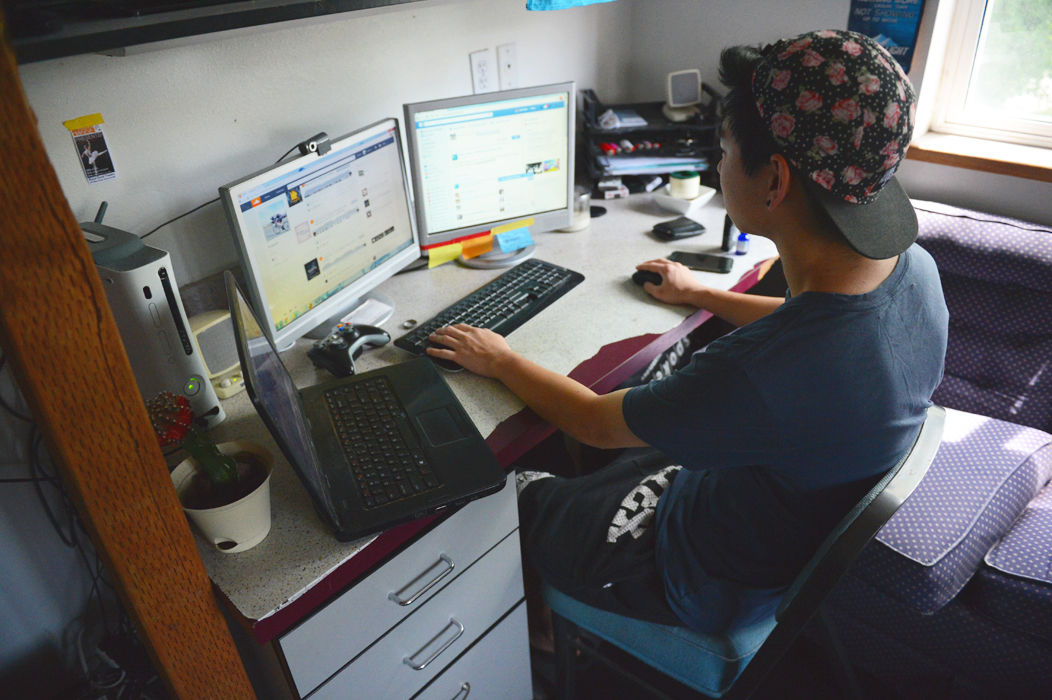E-learning: Untangling the web
Former WSU student Daniel Nam browses the internet on multiple monitors. More than 3,000 students are enrolled in WSU’s Online Global Campus
February 2, 2016
Long gone are the days of dial-up, of waiting in agony for the computer to make those screeching noises before allowing you to receive its bountiful gifts—the Google Machine.
Online learning has its appeals and its drawbacks. If you think Twitter is fraught with misspellings, misquotes, a zest of racism and topped with ignorance, I am afraid WSU Global Campus doesn’t do much better. Perhaps this is part of the plight of online learners.
According to a comparative analysis done by researchers from the University of Illinois at Urbana-Champaign, without face-to-face interaction people don’t feel as connected to their words or have to deal with emotions in the same way as in classrooms. Nor can professors handle the students’ needs.
Admittedly, the courses I am currently taking are far better than what used to be expected in online coursework, but students still try to cut corners where they can.
Look, I get it. You enrolled online so you didn’t have to deal with being in class, and school probably isn’t your first job. It might be something you have to come home and do after a long day of work. But that doesn’t mean you should skimp on difficult stuff and still expect an A.
Some studies have said online learning is worse and others say it is better. Even the BBC has taken a swing at online learning spaces with their education section — the page has been archived and is no longer updated but the fact remains online learning isn’t going anywhere.
Many courses and spaces have quizzes, lectures, readings and interactive materials: how are students supposed to know the best resources to use or how to manage time effectively? And how can students get that face-to-face interaction that is linked to their success? As noted by educator John Watson in a 2008 report, “the integration of face-to-face and online learning … helps enhance the classroom experience and extend learning through the innovative use of information and communications technology.”
Truthfully, there is no right or wrong answer, nor is there a helpful guide to allow students to pick and choose how they learn best because in the current Global Campus system, only some tasks are worth points.
The most effective online course I took was one that offered points for a variety of tasks. One could watch videos, take quizzes, do a mini research assignment or watch a full-length film and do a write-up. The driving point of the course was to do as much work as you can per week to rack up points and the final grade was based on a flat point scale.
More or less, you could earn the grade you wanted by putting in the work. Even if you bombed an exam or a few quizzes there were still plenty of weekly things for you to do. I very much preferred the “Choose Your Own Adventure” method of learning in contrast to the “here’s the bare minimum, do it by this date” method.
Just like in class there’s always students that want to turn things in at the last minute or after the deadline and expect to get full marks. But, my fellow readers, this type of last minute behavior isn’t normally accepted or rewarded in the real world.
As someone who has spent years in the workforce, I can tell you employers will not be happy if you turn in papers after they are due. Situations like that can cost companies valuable resources.
Nor are employers impressed when their employees skimp or try to cut corners because they spent all day on Facebook instead of doing their job.
There is no easy way to navigate online course spaces, nor is there a really good way to develop those much-needed face-to-face interactions yet, and WSU’s Global Campus could help itself out by being open to trying new methods of learning to make sure students get the best education for their money.



















